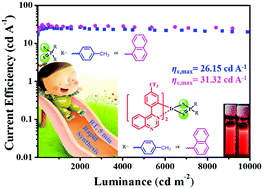Sulfur atom containing ligands induced rapid room temperature synthesis of red iridium(iii) complexes with Ir–S–P–S structures for OLEDs†
Abstract
Two novel sulfur atom containing ligands (triethylamine salts of di-p-tolylphosphinodithioic acid (mess) and di(naphthalen-1-yl)phosphinodithioic acid (niss)) were first developed for red iridium(III) complexes (tfmpqz)2Ir(mess) and (tfmpqz)2Ir(niss) with Ir–S–P–S four membered ring structures, in which 4-(4-(trifluoromethyl)phenyl)-quinazoline (tfmpqz) was used as a cyclometalated ligand. Both Ir(III) complexes were obtained rapidly at room temperature in 5 min in high yields due to the strong coordination ability of the S atom with the iridium atom, and the calculated Gibbs free energy changes of formation reactions of both complexes further prove that they are exothermic and thermodynamically beneficial processes. They show similar PL emissions at 623 and 619 nm with high phosphorescence quantum yields of 0.62 and 0.65, respectively. Using the two complexes as dopants, both organic light emitting devices (OLEDs) with the structure of ITO/HATCN (hexaazatriphenylene hexacarbonitrile, 5 nm)/TAPC (bis(4-(N,N-ditolylamino)phenyl)cyclohexane, 30 nm)/(tfmpqz)2Ir(mess) or (tfmpqz)2Ir(niss): 26DCzppy (2,6-bis-(3-(carbazol-9-yl)phenyl)pyridine) (12 wt%, 10 nm)/TmPyPB (1,3,5-tri((3-pyridyl)-phen-3-yl)benzene, 30 nm)/LiF (1 nm)/Al (100 nm) achieve good performances. In particular, the device using the (tfmpqz)2Ir(niss) complex exhibits better device performances with a maximum luminance of 43 643 cd m−2, a maximum current efficiency of 31.32 cd A−1, a maximum power efficiency of 22.35 lm W−1 and a maximum external quantum efficiency of 19.90%.



 Please wait while we load your content...
Please wait while we load your content...